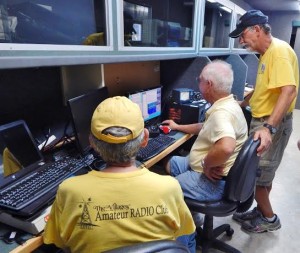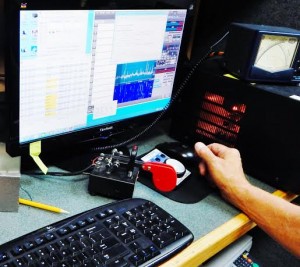
The Villages Amateur Radio Club (TVARC) were major participants in the nationwide annual Field Day this weekend. The Field Day is a 24-hour emergency preparedness exercise sponsored by the American Radio Relay League (ARRL) — the national organization for amateur radio in the USA.
During the Field Day, amateur radio clubs all over the country set up temporary stations, using emergency power, and make on-air contacts with as many stations as possible.
With the assistance of Sumter County Sheriff Bill Farmer’s Office, who lent the group their mobile command center and main antenna, TVARC set up their operation in air-conditioned comfort behind the Sumter County Sheriff’s Annex.

The volunteers were grateful for the SCSO’s well-equipped and comfortable trailer, which shielded them from 100-degree afternoon temperatures. The set-up began at 2 p.m. on Friday. Operations began at 2 p.m. on Saturday, and were slated to run until 2 p.m. on Sunday.
“The premise for the annual drill, which is set up in contest mode,” club president Rich Erlichman (ND4G) explained, “is to prove local amateur radio operators can have a functional emergency management communications center available quickly in the event of a hurricane, tornado, or other catastrophe in which everyday modes of communications infrastructure is down.
“We don’t specify what kind of disaster the drill simulates,” Erlichman continued. “It could be an act of war, a storm, just about anything — and it’s a contest that isn’t really a contest. What I mean is that nobody wins any big money — but the operators get involved for the recognition, for enjoyment, and to demonstrate that they can accomplish what’s needed within a good time frame.
“As an example, with a hurricane like we had in 2004, or the 2007 tornado, when police and other radios didn’t work, we could contact Tampa or other local areas, who could send ambulances, medicine, additional police or fire personnel — whatever might be needed.”

In rotating shifts, teams of volunteers, including Maury Schwartz (K6LWD), Wayne Brown, Pete Stafford (K2PS) and others, simultaneously manned a Morse code CW (continuous wave) transmission unit, using a backup generator; and a guest operator, Glenn Allen W4GJA, visiting from Melbourne, worked on a single side-band set-up using a microphone as well.
“We like the newest FLEX technology we use,” operator Pete Stafford said. SDR stands for software defined radio — it has no buttons.
For demonstration purposes, there was a GOTA unit set up for interested visitors and their grandchildren to learn about HAM radio operations. GOTA stands for Get On The Air — and shows how quickly HAM radio signals can be sent and answered. HAM radio is a popular hobby, with more than 700,000 licensed amateur radio operators in the United States.
Lest one think everything the club does is grim and serious, the group had a delicious cookout at lunchtime on Saturday; and lots of refreshments. Additionally, members Pete Stafford and George Briggs (K2DM) traveled to the leeward West Indian island of Monserrat about two weeks ago for a similar practice drill.

“The 1997 volcanic eruption devastated two-thirds of the island, including the port and the airport,” Stafford related, “and their tourism industry is all but wiped out. But from a radio operator’s point of view, it was exciting. The minute we sent our first signal: ‘We are here’ with Monserrat’s call letters, everything lit up immediately — there were so many replies — because there hadn’t been much radio activity from that part of the world lately.”
Fellow volunteers razzed Stafford, asking him if he got beach sand in his radio equipment — but according to Stafford, operations were all indoors in a serene guest house.
The group welcomes drop-in visitors who are interested in seeing how HAM radio operates. For more information, go to www.arrl.org.

